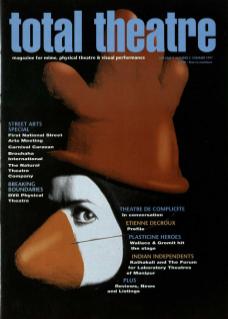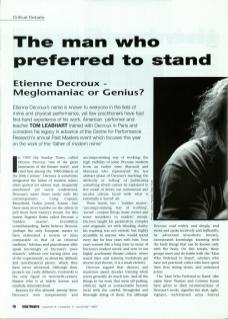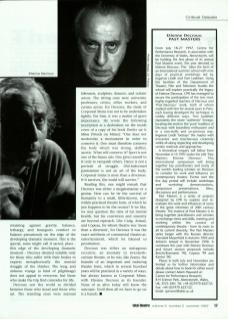In 1992, The Sunday Times called Ètienne Decroux 'one of the great luminaries of the theatre world', and cited him among the '1000 Makers of the 20th Century'. Decroux is sometimes designated the father of modern mime; often quoted yet seldom read, frequently mentioned yet rarely understood, Decroux's name flows easily with his contemporaries – Craig, Copeau, Meyerhold, Dullin, Jouvet, Artaud – but there seem more handles on the others to pull them from history's stream. For this reason Eugenio Barba called Decroux a ‘hidden master'. Invisibility notwithstanding, Barba believes Decroux is 'perhaps the only European master to have elaborated a system of rules comparable to that of an Oriental tradition’. Scholars and practitioners alike speak knowingly of Decroux's 'pure research', without ever having done any of the 'experiments', or about his ‘difficult and non-theatrical pieces', which they have never witnessed. Although their projects are vastly different, Grotowski is the only figure in twentieth-century theatre who is as widely known and similarly misunderstood.
Reasons for this abound, among them: Decroux's own temperament and uncompromising way of working; the high visibility of some Decroux students from an earlier time (Barrault and Marceau) who represented the less abstract phase of Decroux's teaching; the difficulty of 'selling' or publicising something which cannot be explained in five words or fewer; our commercial and secular culture faced with what is essentially a 'sacred' art.
These words, too – 'hidden master', ‘uncompromising way of working', 'sacred' – conjure things (some correct and some mistaken) in readers' minds. Decroux taught his paradoxical, complex and enigmatic art with blinding clarity; his teaching was not esoteric but highly accessible to anyone who would spend every day for four years with him. Four years seemed like a long time to many of Decroux's student actors; and now in our highly accelerated theatre culture, where sound bites and training workshops get shorter and shorter, it is a small eternity.
Decroux argued that dancers and musicians spend decades training while actors generally do much less. And all the things in his work that seem off-putting, artificial, rigid or unreasonable become lucid with the careful, thoughtful and thorough doing of them. For although Decroux read widely and deeply, and wrote and spoke incisively and brilliantly, he advocated kinaesthetic literacy, incorporated knowledge, knowing with the body things that can be known only with the body. On this terrain, three groups meet and do battle with the ‘Man Who Preferred to Stand': scholars who have not practiced; critics who have spent their lives sitting down; and untrained actors.
The 'Man Who Preferred to Stand' (the name Steve Wasson and Corinne Soum have given to their reconstructions of Decroux's work), signifies the alert, agile, vigilant, well-trained actor forever straining against gravity, balance, lethargy, and bourgeois comfort to balance precariously on the edge of the developing dramatic moment. This is the special, some might call it sacred, place – this edge of the developing dramatic moment – Decroux deemed suitable only for those who suffer with their bodies to express metaphorically the mental struggle of the thinker. The long and arduous voyage (a kind of pilgrimage) does not appeal to everyone, but those who make the trip find comrades for life.
Decroux saw the world as divided between those who stood and those who sat. The standing ones were manual labourers, sculptors, dancers, and certain actors. The sitting ones were university professors, critics, office workers, and certain actors. For Decroux, the study of Corporeal Mime was not to be undertaken lightly. For him, it was a matter of grave importance. He wrote the following inscription as a dedication on the inside cover of a copy of his book Paroles sur le Mime (Words on Mime): ‘One does not modernise a monument in order to conserve it. One must therefore conserve the body which was strong, skilful, ascetic. What will conserve it? Sport is not one of the beaux arts. One gives oneself to it only to vanquish others. Dance is not a portrait of struggle. Old-fashioned pantomime is not an art of the body. Corporeal mime is more than a diversion. If it survives, the world will survive.’
Reading this, one might remark that Decroux was either a megalomaniac or a genius. How can he tie the survival of humanity to a small, little-known, not widely practiced theatre form, of which he just happens to be the creator? If we like, we may question the state of his mental health, but his conviction and sincerity are beyond reproach. Like Craig, Artaud, and Copeau, for whom theatre was 'more than a diversion', for Decroux it was the exact antithesis of commercial theatre-as-entertainment, which he likened to prostitution.
Decroux was either an outrageous eccentric, an anomaly in twentieth-century theatre, or he was, like Zeami, the founder of an important and enduring theatre form, which in several hundred years will be practiced in a variety of ways, but always known as Corporeal Mime, with Ètienne Decroux as its founder. None of us alive today will know the outcome. Until then all we have to go on is a hunch.
Ètienne Decroux: PAST MASTERS
From 18-27 July 1997, Centre for Performance Research, in association with the University of Wales, Aberystwyth, will be holding the first phase of its annual Past Masters event, this year devoted to Ètienne Decroux. This takes the form of an international summer school with nine days of practical workshops led by Ingemar Lindh and Tom Leabhart. Using the facilities of the Department of Theatre, Film and Television Studies the school will explore practically the legacy of Ètienne Decroux. CPR has managed to secure the participation of the two most highly-regarded teachers of Decroux and 'Post-Decroux' work, both of whom studied with him for several years in Paris, each having developed the technique in widely different ways. Tom Leabhart represents the more 'authentic' lineage, locating the work in the 'pure' tradition of Decroux with boundless enthusiasm and in a non-stuffy and un-precious way. Ingemar Lindh 'betrays' the master with irreverent and mischievous creativity whilst all along respecting and developing certain methods and approaches.
A theoretical enquiry will follow from 6-10 November 1997 under the title 'Past Masters: Ètienne Decroux'. This international symposium will bring together key practitioners and many of the world's leading scholars on Decroux to consider his work and influence on contemporary theatre. Events over the five-day period will include workshops and workshop demonstrations, symposium presentations, films, discussions and performances.
Past Masters is a series of projects designed by CPR to explore and re-evaluate the work and influences of some of the great reformers of 20th century theatre. The essence of Past Masters is to bring together practitioners and scholars to exchange views and skills, meeting and working within the context of contemporary theatre – from its roots to all its current diversity. The Past Masters series began with the Russian director Vsevolod Meyerhold in Autumn 1995 and Antonin Artaud in November 1996. It continues this year with Ètienne Decroux and future session proposals include Brecht/Eisenstein '98, Copeau '99 and Kantor '00.
Places in both July and November are limited so for further information and details about how to book for either event please contact Adam Hayward at: Centre for Performance Research, 8 H Science Park, Aberystwyth, Wales, UK, SY23 3AH. Tel: +44 (0)1970 622133. Fax: +44 (0)1970 622132. Email: cprwww@aber.ac.uk


